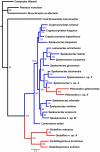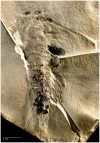Global biodiversity and phylogenetic evaluation of remipedia (crustacea)
- PMID: 21625553
- PMCID: PMC3098257
- DOI: 10.1371/journal.pone.0019627
Global biodiversity and phylogenetic evaluation of remipedia (crustacea)
Abstract
Remipedia is one of the most recently discovered classes of crustaceans, first described in 1981 from anchialine caves in the Bahamas Archipelago. The class is divided into the order Enantiopoda, represented by two fossil species, and Nectiopoda, which contains all known extant remipedes. Since their discovery, the number of nectiopodan species has increased to 24, half of which were described during the last decade. Nectiopoda exhibit a disjunct global distribution pattern, with the highest abundance and diversity in the Caribbean region, and isolated species in the Canary Islands and in Western Australia. Our review of Remipedia provides an overview of their ecological characteristics, including a detailed list of all anchialine marine caves, from which species have been recorded. We discuss alternative hypotheses of the phylogenetic position of Remipedia within Arthropoda, and present first results of an ongoing molecular-phylogenetic analysis that do not support the monophyly of several nectiopodan taxa. We believe that a taxonomic revision of Remipedia is absolutely essential, and that a comprehensive revision should include a reappraisal of the fossil record.
Conflict of interest statement
Figures







References
-
- Yager J. Remipedia, a new class of Crustacea from a marine cave in the Bahamas. J Crust Biol. 1981;1:328–333.
-
- Fanenbruck M, Harzsch S. A brain atlas of Godzilliognomus frondosus Yager, 1989 (Remipedia, Godzilliidae) and comparison with the brain of Speleonectes tulumensis Yager, 1987 (Remipedia, Speleonectidae): implications for arthropod relationships. Arthropod Struct Dev. 2005;34:343–378.
-
- Koenemann S, Schram FR, Iliffe TM. Trunk segmentation patterns in Remipedia. Crustaceana. 2006;79:607–631.
-
- Koenemann S, Schram FR, Iliffe TM, Hinderstein LM, Bloechl A. The behavior of Remipedia (Crustacea), with supporting field observations. J Crust Biol. 2007;27:534–542.
-
- Koenemann S, Olesen J, Alwes F, Iliffe TM, Hoenemann M, et al. The post-embryonic development of Remipedia (Crustacea)—additional results and new insights. Dev Genes Evol. 2009;219:131–145. - PubMed
Publication types
MeSH terms
LinkOut - more resources
Full Text Sources

